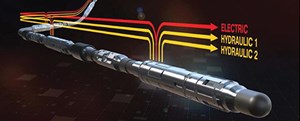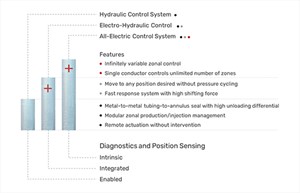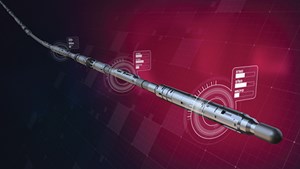Advanced reservoir control systems enable digital offshore operations and analysis
Digital offshore operations and analysis are possible through the deployment of downhole completion technologies that produce large quantities of data. Although data are crucial in understanding reservoir characteristics and field-wide interactions, the ability to quickly respond, manage and control downhole events is of utmost importance to maximize the benefits of digital operations.
Advanced reservoir control systems help maximize the benefits of digital operations by integrating downhole data from multiple sources and providing rapid management and control of wellbores with minimal control line penetrations. While it is true that the future of smart completions will rely heavily on electric technologies versus hydraulics, today, using downhole monitoring systems and a robust digital ecosystem, operators can benefit from utilizing multiple levels of digitalization, regardless of the type of advanced reservoir control system deployed.
SMART COMPLETION EVOLUTION
To realize the benefits of digitalization and advanced reservoir control systems, it is important to understand how wellbore monitoring and smart flow control systems were developed. The information presented in the next sections focuses on the specific industry needs that led to development of certain flow control system features over time.
With this approach, we will explain how some of these technologies served as minimum viable products that fit a market need, and how trends eventually evolved the systems to the choices we have today. The timeline highlights the progression and development of smart completion technologies, starting with monitoring technologies and their purpose in providing greater reservoir understanding, and eventually culminating in closer integration with remote flow control systems, Fig. 1.
NEED FOR WELLBORE MONITORING
Before discussing downhole control systems used in smart completions, it is important to discuss the advancements in downhole electronics, telemetry and sensor technology.
Electronics. In the 1980s, the industry began to use electronics in downhole completions. Permanent downhole gauges could provide real-time data, enabling long-term production insights for reservoir teams. The initial challenges with permanent downhole gauges were around sensor drift and reliability at high temperatures. Vibration was another component inducing an extra dimension of difficulty, given printed circuit board (PCB) technology was prone to vibration problems and delamination at high temperatures.
Thanks to such monitoring technologies, reservoir teams could make inferences regarding cross-zone and cross-well communications, sweep efficiencies in enhanced oil recovery (EOR) applications, or water breakthrough at lateral junctions, to name a few. In the last few years, the reliability and operational efficiency of these monitoring systems has allowed service companies to push the boundaries of pressure and temperature environments, where these technologies can be deployed.
Furthermore, low power consumption is one of the most important parameters to consider in an electronics design, especially when trying to integrate both permanent monitoring and flow control systems. Power consumption can affect the size of flow control valves actuated, due to the loads commanded by downhole actuators or pumps, as well as the depth and quantity of control intervals that can be deployed. Additionally, the amount of power necessary to successfully acuate such systems might also affect the size and real estate of surface equipment, which has a real economic impact, especially in subsea applications.
Telemetry. There are multiple, well-known telemetry scheme types for communicating with downhole components. The telemetry scheme, combined with a robust dataset architecture, can impact the overall limitations of a system. The telemetry scheme choice could impact a system’s ability to push the boundaries of power and depth, speed of communication, ability to send multiple data sets up-hole and ultimately its ability to handle power-hungry actuations from a flow control system.
Sensors. As the industry’s acceptance of electronics grew, data gathered from downhole sensors provided more accurate insights to reservoir teams versus extrapolated downhole parameters. Pressure and temperature quartz transducer technology proved very effective against high temperatures and pressures and were a perfect fit for monitoring multi-zone completions and multilaterals, in addition to standard completions. The data generation breakthrough provided by downhole quartz technologies is augmented by the development and deployment of fiber optic technologies, with their ability to produce a greater granularity of temperature and acoustic sensing points across the wellbore.
Big data cannot be leveraged fully without reliable data, so not only is it important to choose the right downhole sensor, or combination of sensors, but also the right electronics and telemetry scheme, especially when being integrated into a flow control system. With the correct combination of technologies, reservoir and production teams can confidently rely on the data that are produced from each completion, which can ultimately be fed into a digital ecosystem for complete analysis and simulation.
NEED FOR REMOTE CONTROL
With greater understanding of the reservoir using monitoring technologies, operators began looking at ways to optimize their production or injection in different wellbores.
Sliding sleeves. Initially, slickline-shifted sliding sleeves provided means of controlling production or injection. Offshore costs for wireline deployments, and the inefficiency of selectivity of such systems was challenging. Not only was it costly to deploy wireline systems, but the amount of force that was able to be transferred from the surface to reach and shift sliding sleeves was limited.
First smart well. To counter the challenges with conventional sliding sleeves, smart completions were developed initially to reduce the economic and operational risks of shifting sleeves via wireline operations. A greater emphasis on “remote control” of sliding sleeves gave way to interval control valves (ICVs).
The first electro-hydraulic systems offered tremendous versatility, but they were expensive and plagued with reliability and temperature shortcomings of early downhole electronics. Redundancy was often used to overcome the reliability problems with these early systems (Shaw, 2011). Systems utilized PCB electronic circuitry to communicate and engage different zones and had full line and electronic circuitry redundancy to ensure the systems would successfully function for 10+ years. In addition, the systems utilized an infinitely variable ICV with position sensor feedback for precise zonal control.
Wellbore compartmentalization. As wellbore compartmentalization became more standardized in EOR applications and other completion designs, a need for increased zonal control became a necessity. With drilling advancements and an emphasis on maximum reservoir contact, operators wanted to increase the wellbore control to, for example, balance production or injection from multiple intervals or prevent cross-flow. In terms of their importance to overall wellbore control, smart completions provide a key capability to affect the flow of fluids into and from the reservoir, particularly in reservoirs with complex geology, in wells with complex architecture, or in advanced recovery schemes. As such, intelligent wells form the backbone for the intelligent field (Konopczynski, 2008).
Zonal control. With the ability to remotely control ICVs, operators started to ask for greater zonal control. Specifically, they noticed that the ability to regulate production or injection on demand from the surface might help prevent skin effects, water production, or eliminate cross-flow between multiple zones. A valve’s flow coefficient (Cv) describes a valve’s capacity for gas or liquids to flow through its flow trim openings. Infinitely variable ICVs are advantageous if very finite Cv curve percentages are required, but most applications can be satisfied with discrete incremental positions from a well-designed ICV flow trim. Another important aspect of ICVs is their ability/inability to maintain full-bore production or injection while fully open. In terms of zonal control and the greater reservoir management implications, full-bore production or injection can significantly affect the wellbore’s potential for controlling reservoir events.
NEED FOR DIGITAL OILFIELD INTEGRATION AND PROACTIVE MANAGEMENT
Today, we see digital oilfield integrations and proactive reservoir management as a direct result of advancements in high-temperature downhole electronics and their overall success with permanent downhole gauge telemetry. The successes of early remotely actuated hydraulic and electro-hydraulic control systems, combined with permanent downhole gauge telemetry, provide robust technologies that can accelerate reservoir control system response, reliability, and interfaces to other digital oilfield technologies, while affording the opportunity to control more zones.
Advanced reservoir control system types. There are currently three major categories of reservoir control systems: 1) hydraulic; 2) electro-hydraulic; and 3) all-electric systems. These systems can be viewed as the starting blueprints for a smart completion, and an operator’s infrastructure may determine the type of system to be deployed. Furthermore, these reservoir control systems can be subdivided into extrinsic and intrinsic advanced reservoir control systems. The following sections highlight each of these control systems, with an emphasis on their abilities and limitations for becoming advanced reservoir control systems.
Hydraulic systems. Hydraulic reservoir control systems are widely considered to be the simplest in terms of remote actuation and, to date, have been the most common type of control system deployed. Hydraulic control systems are considered extrinsic in terms of Advanced Reservoir Control Systems, due to their inability to convey downhole data. They are stand-alone systems that would require a secondary and independent monitoring system for more advanced insights.
Control schemes for these systems vary, but the most common is the N+1 control line configuration, where N is the number of zones controlled. Overall, hydraulic systems have the inherent disadvantage of having to wait for the control line to pressurize, which in turn emits a force across the piston area of an ICV to induce a shift. While this inherent design characteristic is robust in producing substantial piston forces, the detriment is the amount of time it takes to actuate such systems. Depending on the operator’s infrastructure, and the number of feedthrough ports at the hanger, operators can utilize hydraulic downhole control systems for completions with minimal amounts of zonal control. For these systems to become extrinsic advanced reservoir control systems, additional ad-hoc downhole monitoring systems must be deployed to provide necessary reservoir production or injection feedback.
Electro-hydraulic systems. The first electro-hydraulic system combined downhole monitoring sensors, position sensors, and downhole valve actuators, which could be selectively engaged from the surface with a telemetry communication protocol. Developed ahead of its time, such an electro-hydraulic system would have been qualified today as an intrinsic advanced reservoir control system.
Prior to the development of today’s high-temperature electronics, redundancy was often viewed in the oil field to increase reliability, especially when equipment was expected to last 10 years or more. Taking into consideration that the reliability of electronics at high temperatures was significantly lower in 1997 than today, design engineers decided to increase the number of components in the system by essentially packaging two systems into one: a primary system and a backup system. Such an increase of system components resulted in an increased total system cost, which hindered the system’s adoption.
To reduce component count and cost from the entire system, a simple type of electro-hydraulic extrinsic system was developed, where advanced reservoir control is provided by a set of passive electrical components. These electrical components utilize no telemetry, and instead use a multiplexing scheme to engage different ICVs distributed along multiple wellbore zones. The extrinsic electro-hydraulic control system uses two hydraulic lines for ICV movement, and one electric line for ICV selectivity.
All three of these lines connect into a surface control unit capable of supplying the hydraulic pressure and electrical current necessary to select each one of the ICVs deployed in the completion. The higher electronic reliability has essentially eliminated the need for redundant electronics, leaving redundancy as an upgrade feature to be considered, based on project budget and goals. Intrinsic electro-hydraulic systems benefit from faster response than all-hydraulic systems, and given that they share telemetry with an inclusive monitoring system, intrinsic electro-hydraulic systems can be used to implement advanced reservoir control workflows.
All electric systems are the next step in the evolution of advanced control systems. These systems are intrinsic advanced reservoir systems, as they already have telemetry that is shared amongst multiple devices in the all-electric architecture. Recent developments on electric motor efficiencies and capabilities have enabled the technology to produce high forces, comparable to those in all-hydraulic systems. With a single electric TEC line to command and control multiple zones, these systems provide reservoir feedback in terms of pressures and temperatures, as well as integrated position sensing, virtual flow metering, and overall system diagnostic data via telemetry to its surface equipment.
One important aspect to consider when deploying all-electric technologies is the system’s ability to keep full-bore production or injection flow. While the introduction of a faster system response is important, flow restrictions due to ICV design can affect an asset’s overall potential. The ICV design does not restrict flow, and when coupled with the all-electric infrastructure, provides the benefits of accurate valve positioning, full-bore production/injection, and the speed of actuation provided by all-electric systems. Another advantage is their ability to integrate to other similar systems. In such smart completions, not only would ICVs and gauges interact with each other, but they could also interact with electric safety valves, and other all-electric completion technologies. The ultimate benefit of deploying compatible all-electric systems is that umbilicals can be simplified, and overall CAPEX can be reduced for offshore applications.
While operationally more difficult to deploy in comparison to intrinsic advanced reservoir systems, the reality is that extrinsic systems have been deployed successfully for more than 20 years. With the appropriate level of design, processes and planning, extrinsic systems can be deployed successfully while reliably providing the necessary wellbore monitoring and control to proactively manage reservoirs, Fig. 2. Operators must consider wellbore and field infrastructure, degree of reservoir control necessary (proactive vs reactive) and system costs.
Intrinsic advanced reservoir control system evaluation. Hybrid-electric systems also can allow for monitoring capabilities for proactive and near-instantaneous optimization. In general, these systems can monitor and control upwards of 10 zones with a minimum of three penetrations. Another important feature is the ability to integrate communications with downhole gauges and other electrical peripheral components, such as position sensors. In fact, with the use of a tubing and annulus gauge setup, these electro-hydraulic systems can provide multiphase virtual flow metering, to estimate zonal contribution, Fig. 3.
Thorough analysis of accurate zonal flow rate estimates is required for effective reservoir management and ICV performance evaluation. These may be achieved by use of a nodal analysis model against PLT measurements, real-time downhole pressures and surface measurements to optimize the well’s performance. The zonal production split of the well needs to be determined every time the position of an ICV’s trim is altered or well conditions change over time (Hussain).
DIGITALIZATION BASED ON SYSTEM SELECTION
Preliminary testing and results are shown for a fully integrated electro-hydraulic system capable of providing telemetry for an increased number of controlled zones, diagnostics, and integration with permanent downhole gauges. The next-generation electro-hydraulic control system module relies on the use of current hydraulic ICV technology and ASIC hybrid circuit technology for communication. Simulations show that the system can provide real-time feedback from ICV positioning through a common telemetry protocol shared with permanent downhole gauges. Taking into consideration ICV flow trim design, and using tubing and annulus downhole pressure and temperature data, automated workflows can be implemented to adjust ICV positioning on electro- hydraulic systems in a swift and accurate manner.
CONCLUSION
To date, extensive testing has been done with both types of intrinsic systems. Of the two types, all- electric systems are seen as the long-term solution for the industry. In general, the concept of all-electric digitalization provides a utopian view of where the digital oil field will likely end up, but in practice, a stepwise approach through the implementation of hybrid-electric digital systems is key to the overall acceptance of all-electric systems. The long-term acceptance of electrified components has also been seen across multiple industries.
The success and reliability of electro-hydraulic systems will play a significant role in mass acceptance of all-electric systems in the oil field. Although the future of completions lies in electric systems, digitalization does not have to wait until these systems become mainstream. Electro-hydraulic systems are a good segue into all-electric systems and give operators the chance to utilize some of the existing infrastructure while benefiting from optimizations facilitated by the digital oil field.
- Advancing offshore decarbonization through electrification of FPSOs (March 2024)
- Digital transformation/Late-life optimization: Harnessing data-driven strategies for late-life optimization (March 2024)
- The reserves replacement dilemma: Can intelligent digital technologies fill the supply gap? (March 2024)
- Subsea technology- Corrosion monitoring: From failure to success (February 2024)
- Digital tool kit enhances real-time decision-making to improve drilling efficiency and performance (February 2024)
- Digital transformation: Digital twins help to make the invisible, visible in Indonesia’s energy industry (January 2024)
- Applying ultra-deep LWD resistivity technology successfully in a SAGD operation (May 2019)
- Adoption of wireless intelligent completions advances (May 2019)
- Majors double down as takeaway crunch eases (April 2019)
- What’s new in well logging and formation evaluation (April 2019)
- Qualification of a 20,000-psi subsea BOP: A collaborative approach (February 2019)
- ConocoPhillips’ Greg Leveille sees rapid trajectory of technical advancement continuing (February 2019)






